2019 Hyundai Santa Fe width
[x] Cancel search: widthPage 69 of 682
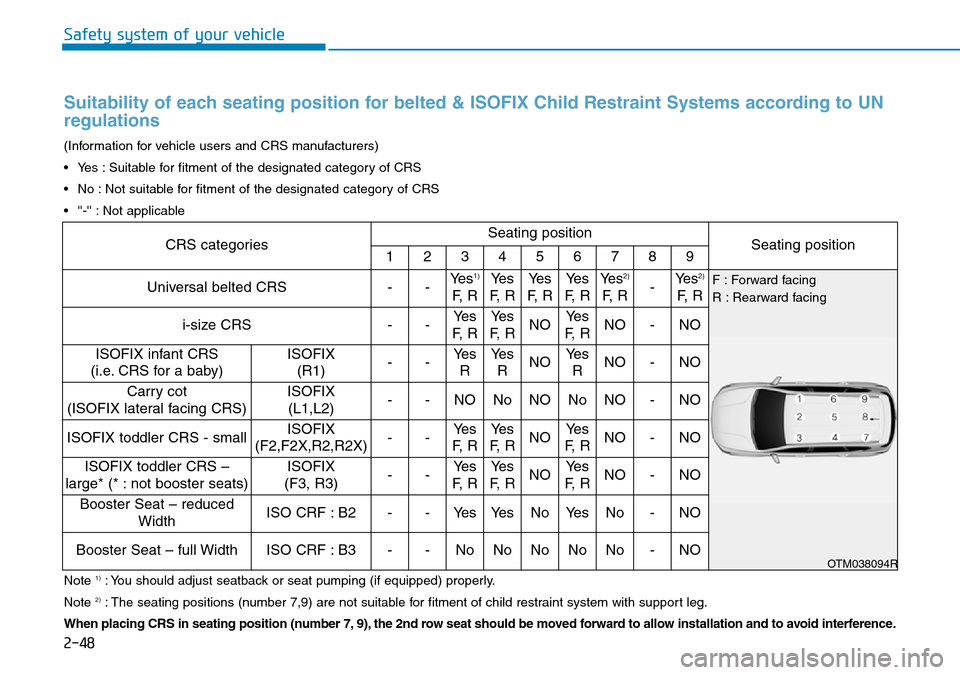
2-48
Safety system of your vehicle
CRS categoriesSeating positionSeating position123456789
Universal belted CRS--Ye s1)
F, R
Yes
F, RYes
F, RYe s
F, RYe s2)
F, R-Ye s2)
F, R
i-size CRS--Yes
F, RYes
F, RNOYes
F, RNO-NO
ISOFIX infant CRS
(i.e. CRS for a baby)ISOFIX
(R1)--Ye s
RYe s
RNOYe s
RNO-NO
Carry cot
(ISOFIX lateral facing CRS)ISOFIX
(L1,L2)--NONoNONoNO-NO
ISOFIX toddler CRS - small ISOFIX
(F2,F2X,R2,R2X)--Yes
F, RYes
F, RNOYes
F, RNO-NO
ISOFIX toddler CRS –
large* (* : not booster seats)ISOFIX
(F3, R3)--Yes
F, RYes
F, RNOYe s
F, RNO-NO
Booster Seat – reduced
WidthISO CRF : B2--Ye sYe sNoYe sNo-NO
Booster Seat – full WidthISO CRF : B3--NoNoNoNoNo-NO
Suitability of each seating position for belted & ISOFIX Child Restraint Systems according to UN
regulations
(Information for vehicle users and CRS manufacturers)
• Yes : Suitable for fitment of the designated category of CRS
• No : Not suitable for fitment of the designated category of CRS
• ''-'' : Not applicable
OTM038094R
F : Forward facing
R : Rearward facing
Note
1): You should adjust seatback or seat pumping (if equipped) properly.
Note
2): The seating positions (number 7,9) are not suitable for fitment of child restraint system with support leg.
When placing CRS in seating position (number 7, 9), the 2nd row seat should be moved forward to allow installation and to avoid interference.
Page 291 of 682
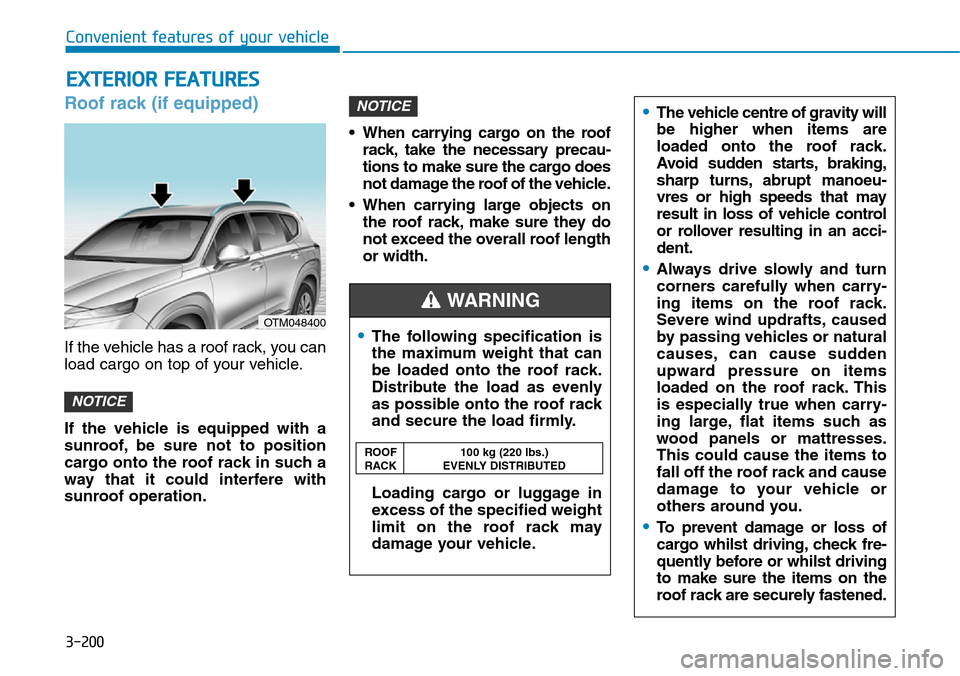
Roof rack (if equipped)
If the vehicle has a roof rack, you can
load cargo on top of your vehicle.
If the vehicle is equipped with a
sunroof, be sure not to position
cargo onto the roof rack in such a
way that it could interfere with
sunroof operation.• When carrying cargo on the roof
rack, take the necessary precau-
tions to make sure the cargo does
not damage the roof of the vehicle.
• When carrying large objects on
the roof rack, make sure they do
not exceed the overall roof length
or width.
NOTICE
NOTICE
EXTERIOR FEATURES
Page 436 of 682
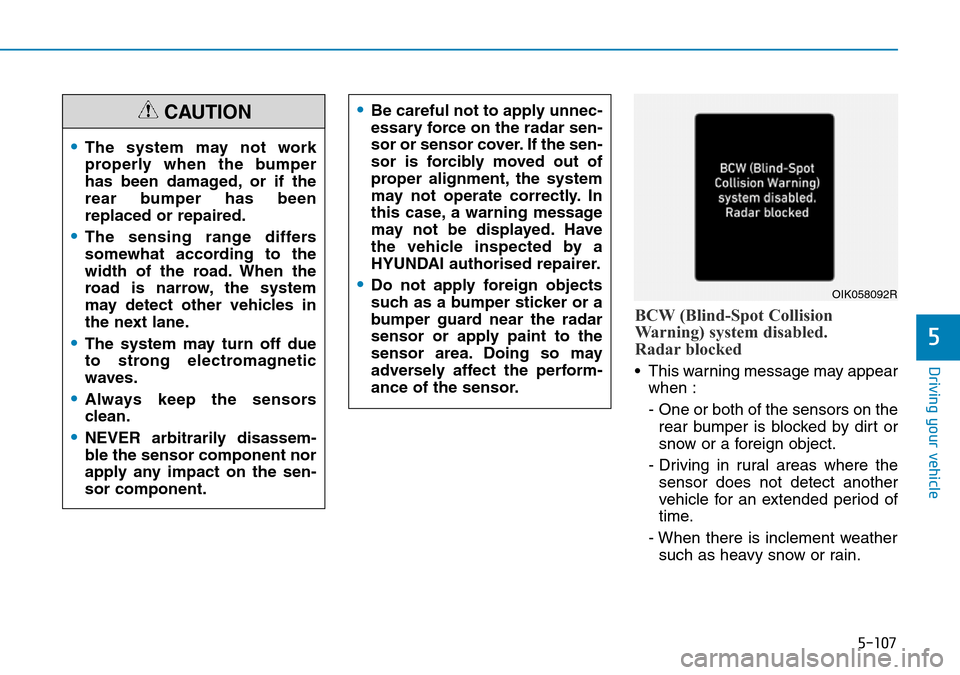
5-107
Driving your vehicle
BCW (Blind-Spot Collision
Warning) system disabled.
Radar blocked
• This warning message may appear
when :
- One or both of the sensors on the
rear bumper is blocked by dirt or
snow or a foreign object.
- Driving in rural areas where the
sensor does not detect another
vehicle for an extended period of
time.
- When there is inclement weather
such as heavy snow or rain.
5
•The system may not work
properly when the bumper
has been damaged, or if the
rear bumper has been
replaced or repaired.
•The sensing range differs
somewhat according to the
width of the road. When the
road is narrow, the system
may detect other vehicles in
the next lane.
•The system may turn off due
to strong electromagnetic
waves.
•Always keep the sensors
clean.
•NEVER arbitrarily disassem-
ble the sensor component nor
apply any impact on the sen-
sor component.
•Be careful not to apply unnec-
essary force on the radar sen-
sor or sensor cover. If the sen-
sor is forcibly moved out of
proper alignment, the system
may not operate correctly. In
this case, a warning message
may not be displayed. Have
the vehicle inspected by a
HYUNDAI authorised repairer.
•Do not apply foreign objects
such as a bumper sticker or a
bumper guard near the radar
sensor or apply paint to the
sensor area. Doing so may
adversely affect the perform-
ance of the sensor.
CAUTION
OIK058092R
Page 458 of 682
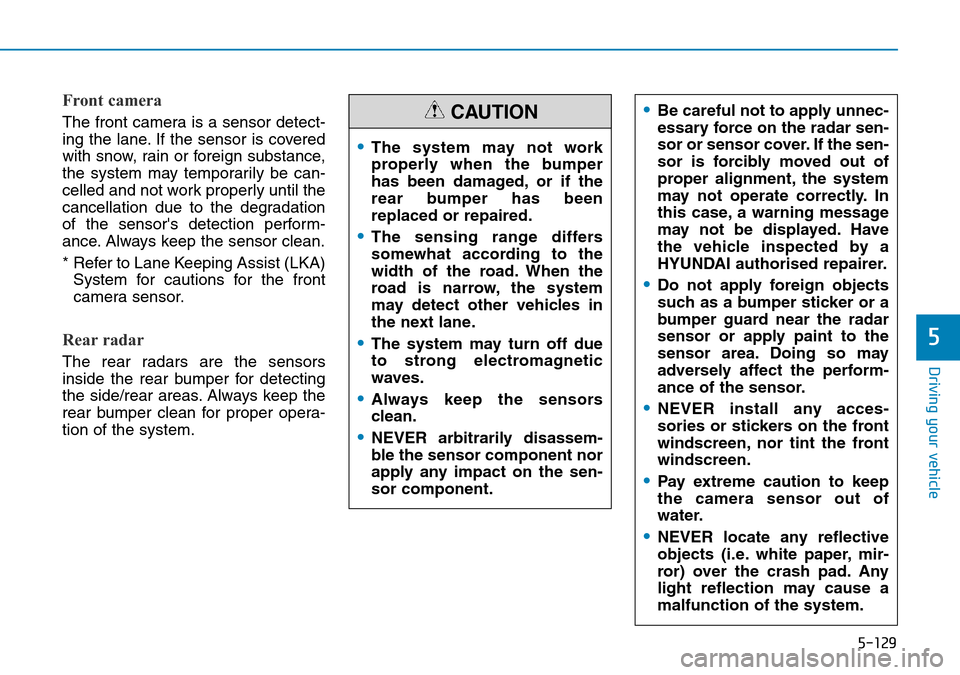
5-129
Driving your vehicle
5
Front camera
The front camera is a sensor detect-
ing the lane. If the sensor is covered
with snow, rain or foreign substance,
the system may temporarily be can-
celled and not work properly until the
cancellation due to the degradation
of the sensor's detection perform-
ance. Always keep the sensor clean.
* Refer to Lane Keeping Assist (LKA)
System for cautions for the front
camera sensor.
Rear radar
The rear radars are the sensors
inside the rear bumper for detecting
the side/rear areas. Always keep the
rear bumper clean for proper opera-
tion of the system.
•The system may not work
properly when the bumper
has been damaged, or if the
rear bumper has been
replaced or repaired.
•The sensing range differs
somewhat according to the
width of the road. When the
road is narrow, the system
may detect other vehicles in
the next lane.
•The system may turn off due
to strong electromagnetic
waves.
•Always keep the sensors
clean.
•NEVER arbitrarily disassem-
ble the sensor component nor
apply any impact on the sen-
sor component.
•Be careful not to apply unnec-
essary force on the radar sen-
sor or sensor cover. If the sen-
sor is forcibly moved out of
proper alignment, the system
may not operate correctly. In
this case, a warning message
may not be displayed. Have
the vehicle inspected by a
HYUNDAI authorised repairer.
•Do not apply foreign objects
such as a bumper sticker or a
bumper guard near the radar
sensor or apply paint to the
sensor area. Doing so may
adversely affect the perform-
ance of the sensor.
•NEVER install any acces-
sories or stickers on the front
windscreen, nor tint the front
windscreen.
•Pay extreme caution to keep
the camera sensor out of
water.
•NEVER locate any reflective
objects (i.e. white paper, mir-
ror) over the crash pad. Any
light reflection may cause a
malfunction of the system.
CAUTION
Page 481 of 682
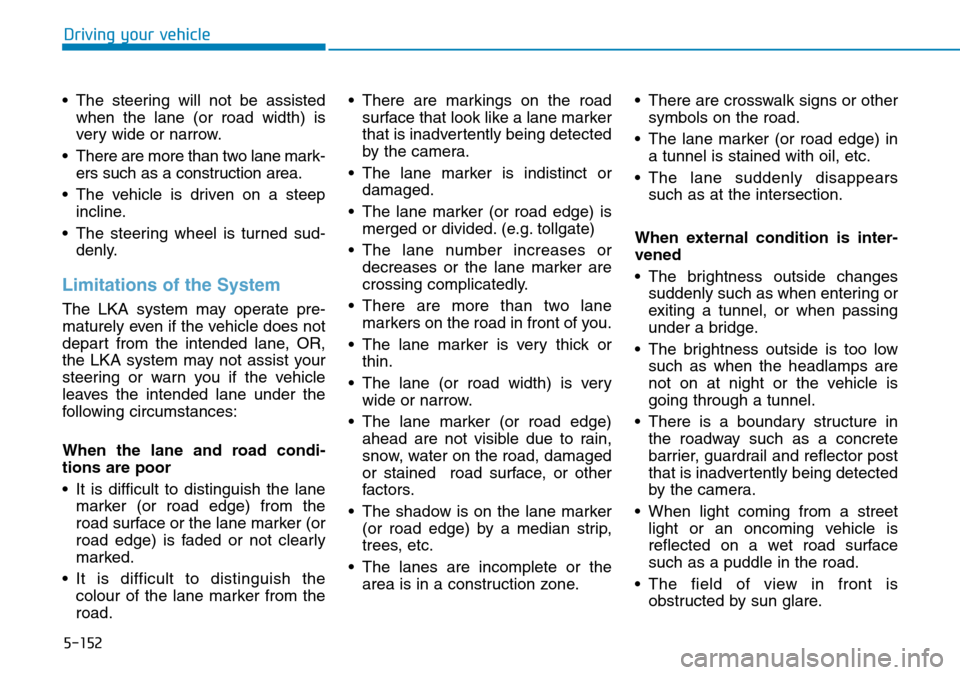
5-152
Driving your vehicle
• The steering will not be assisted
when the lane (or road width) is
very wide or narrow.
• There are more than two lane mark-
ers such as a construction area.
• The vehicle is driven on a steep
incline.
• The steering wheel is turned sud-
denly.
Limitations of the System
The LKA system may operate pre-
maturely even if the vehicle does not
depart from the intended lane, OR,
the LKA system may not assist your
steering or warn you if the vehicle
leaves the intended lane under the
following circumstances:
When the lane and road condi-
tions are poor
• It is difficult to distinguish the lane
marker (or road edge) from the
road surface or the lane marker (or
road edge) is faded or not clearly
marked.
• It is difficult to distinguish the
colour of the lane marker from the
road.• There are markings on the road
surface that look like a lane marker
that is inadvertently being detected
by the camera.
• The lane marker is indistinct or
damaged.
• The lane marker (or road edge) is
merged or divided. (e.g. tollgate)
• The lane number increases or
decreases or the lane marker are
crossing complicatedly.
• There are more than two lane
markers on the road in front of you.
• The lane marker is very thick or
thin.
• The lane (or road width) is very
wide or narrow.
• The lane marker (or road edge)
ahead are not visible due to rain,
snow, water on the road, damaged
or stained road surface, or other
factors.
• The shadow is on the lane marker
(or road edge) by a median strip,
trees, etc.
• The lanes are incomplete or the
area is in a construction zone.• There are crosswalk signs or other
symbols on the road.
• The lane marker (or road edge) in
a tunnel is stained with oil, etc.
• The lane suddenly disappears
such as at the intersection.
When external condition is inter-
vened
• The brightness outside changes
suddenly such as when entering or
exiting a tunnel, or when passing
under a bridge.
• The brightness outside is too low
such as when the headlamps are
not on at night or the vehicle is
going through a tunnel.
• There is a boundary structure in
the roadway such as a concrete
barrier, guardrail and reflector post
that is inadvertently being detected
by the camera.
• When light coming from a street
light or an oncoming vehicle is
reflected on a wet road surface
such as a puddle in the road.
• The field of view in front is
obstructed by sun glare.
Page 612 of 682
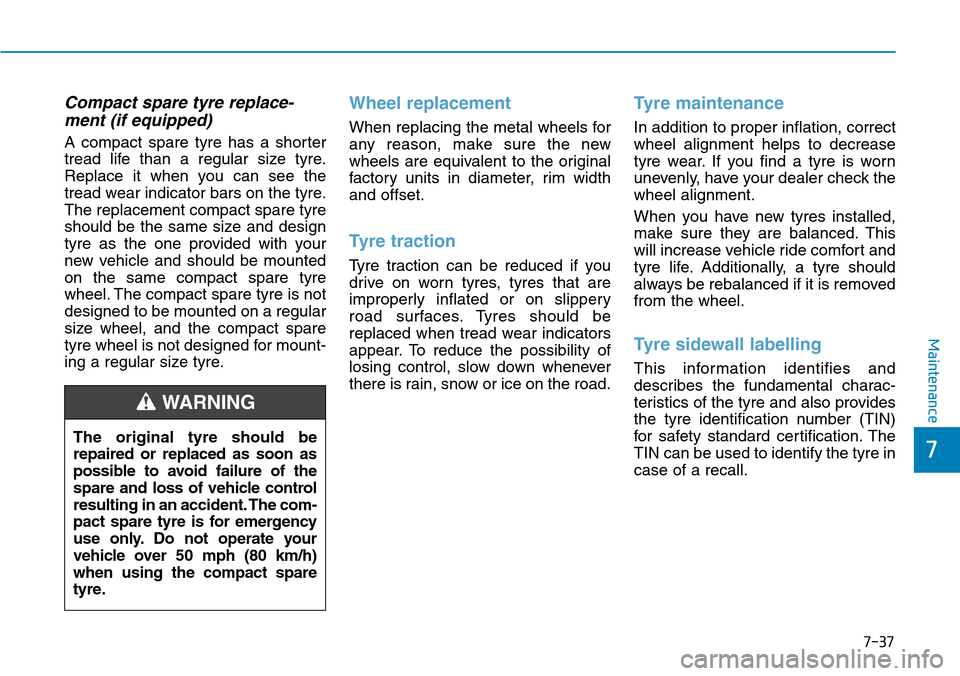
7-37
7
Maintenance
Compact spare tyre replace-
ment (if equipped)
A compact spare tyre has a shorter
tread life than a regular size tyre.
Replace it when you can see the
tread wear indicator bars on the tyre.
The replacement compact spare tyre
should be the same size and design
tyre as the one provided with your
new vehicle and should be mounted
on the same compact spare tyre
wheel. The compact spare tyre is not
designed to be mounted on a regular
size wheel, and the compact spare
tyre wheel is not designed for mount-
ing a regular size tyre.
Wheel replacement
When replacing the metal wheels for
any reason, make sure the new
wheels are equivalent to the original
factory units in diameter, rim width
and offset.
Tyre traction
Tyre traction can be reduced if you
drive on worn tyres, tyres that are
improperly inflated or on slippery
road surfaces. Tyres should be
replaced when tread wear indicators
appear. To reduce the possibility of
losing control, slow down whenever
there is rain, snow or ice on the road.
Tyre maintenance
In addition to proper inflation, correct
wheel alignment helps to decrease
tyre wear. If you find a tyre is worn
unevenly, have your dealer check the
wheel alignment.
When you have new tyres installed,
make sure they are balanced. This
will increase vehicle ride comfort and
tyre life. Additionally, a tyre should
always be rebalanced if it is removed
from the wheel.
Tyre sidewall labelling
This information identifies and
describes the fundamental charac-
teristics of the tyre and also provides
the tyre identification number (TIN)
for safety standard certification. The
TIN can be used to identify the tyre in
case of a recall. The original tyre should be
repaired or replaced as soon as
possible to avoid failure of the
spare and loss of vehicle control
resulting in an accident. The com-
pact spare tyre is for emergency
use only. Do not operate your
vehicle over 50 mph (80 km/h)
when using the compact spare
tyre.
WARNING
Page 613 of 682
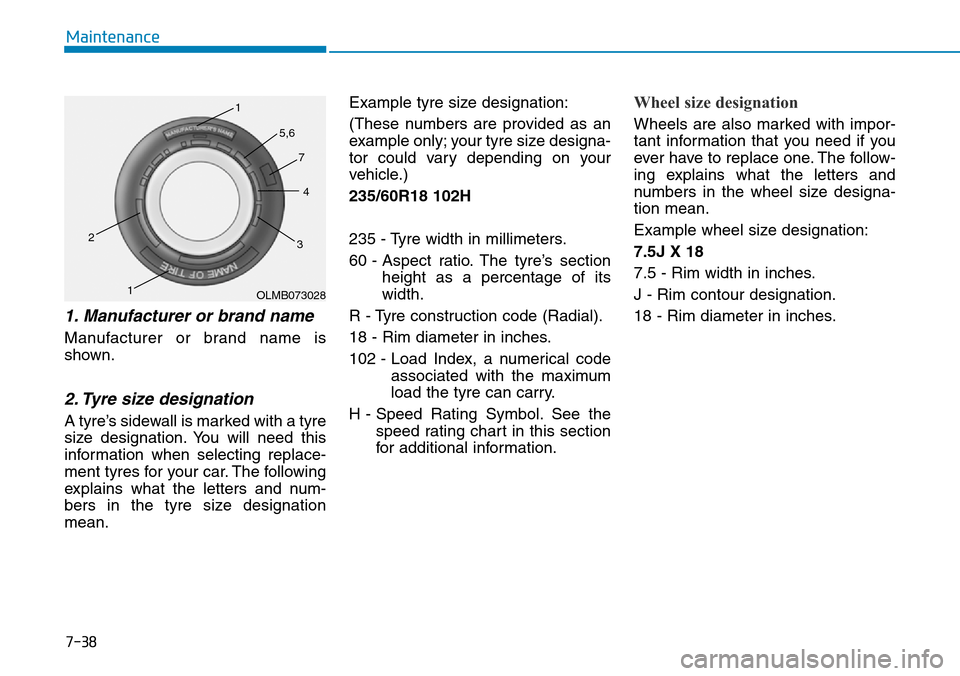
7-38
Maintenance
1. Manufacturer or brand name
Manufacturer or brand name is
shown.
2. Tyre size designation
A tyre’s sidewall is marked with a tyre
size designation. You will need this
information when selecting replace-
ment tyres for your car. The following
explains what the letters and num-
bers in the tyre size designation
mean.Example tyre size designation:
(These numbers are provided as an
example only; your tyre size designa-
tor could vary depending on your
vehicle.)
235/60R18 102H
235 - Tyre width in millimeters.
60 - Aspect ratio. The tyre’s section
height as a percentage of its
width.
R - Tyre construction code (Radial).
18 - Rim diameter in inches.
102 - Load Index, a numerical code
associated with the maximum
load the tyre can carry.
H - Speed Rating Symbol. See the
speed rating chart in this section
for additional information.
Wheel size designation
Wheels are also marked with impor-
tant information that you need if you
ever have to replace one. The follow-
ing explains what the letters and
numbers in the wheel size designa-
tion mean.
Example wheel size designation:
7.5J X 18
7.5 - Rim width in inches.
J - Rim contour designation.
18 - Rim diameter in inches.
OLMB073028 1
1 2
34 5,6
7
Page 615 of 682
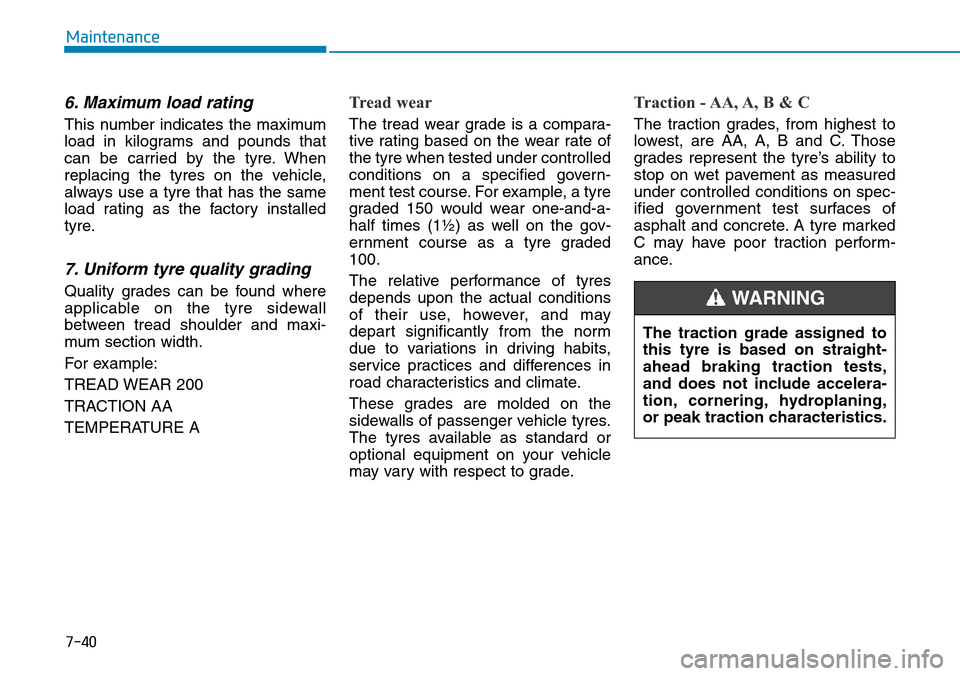
7-40
Maintenance
6. Maximum load rating
This number indicates the maximum
load in kilograms and pounds that
can be carried by the tyre. When
replacing the tyres on the vehicle,
always use a tyre that has the same
load rating as the factory installed
tyre.
7. Uniform tyre quality grading
Quality grades can be found where
applicable on the tyre sidewall
between tread shoulder and maxi-
mum section width.
For example:
TREAD WEAR 200
TRACTION AA
TEMPERATURE A
Tread wear
The tread wear grade is a compara-
tive rating based on the wear rate of
the tyre when tested under controlled
conditions on a specified govern-
ment test course. For example, a tyre
graded 150 would wear one-and-a-
half times (1½) as well on the gov-
ernment course as a tyre graded
100.
The relative performance of tyres
depends upon the actual conditions
of their use, however, and may
depart significantly from the norm
due to variations in driving habits,
service practices and differences in
road characteristics and climate.
These grades are molded on the
sidewalls of passenger vehicle tyres.
The tyres available as standard or
optional equipment on your vehicle
may vary with respect to grade.
Traction - AA, A, B & C
The traction grades, from highest to
lowest, are AA, A, B and C. Those
grades represent the tyre’s ability to
stop on wet pavement as measured
under controlled conditions on spec-
ified government test surfaces of
asphalt and concrete. A tyre marked
C may have poor traction perform-
ance.
The traction grade assigned to
this tyre is based on straight-
ahead braking traction tests,
and does not include accelera-
tion, cornering, hydroplaning,
or peak traction characteristics.
WARNING